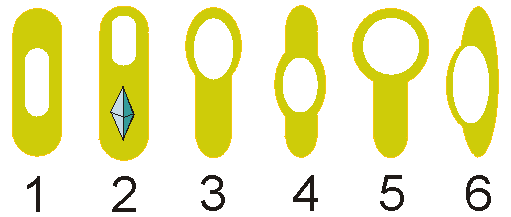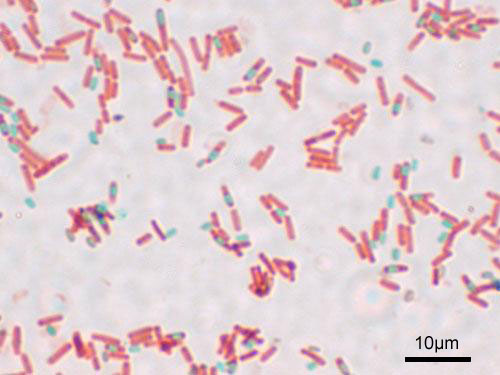Endospore
|
WikiDoc Resources for Endospore |
|
Articles |
|---|
|
Most recent articles on Endospore |
|
Media |
|
Evidence Based Medicine |
|
Clinical Trials |
|
Ongoing Trials on Endospore at Clinical Trials.gov Clinical Trials on Endospore at Google
|
|
Guidelines / Policies / Govt |
|
US National Guidelines Clearinghouse on Endospore
|
|
Books |
|
News |
|
Commentary |
|
Definitions |
|
Patient Resources / Community |
|
Patient resources on Endospore Discussion groups on Endospore Directions to Hospitals Treating Endospore Risk calculators and risk factors for Endospore
|
|
Healthcare Provider Resources |
|
Causes & Risk Factors for Endospore |
|
Continuing Medical Education (CME) |
|
International |
|
|
|
Business |
|
Experimental / Informatics |
Editor-In-Chief: C. Michael Gibson, M.S., M.D. [1]
Overview
An endospore is a dormant, tough, and non-reproductive structure produced by a small number of bacteria from the Firmicute phylum. The primary function of most endospores is to ensure the survival of a bacterium through periods of environmental stress. They are therefore resistant to ultraviolet and gamma radiation, desiccation, lysozyme, temperature, starvation, and chemical disinfectants. Endospores are commonly found in soil and water, where they may survive for long periods of time. Some bacteria produce exospores or cysts instead.

Structure
In contrast to eukaryotic spores, which are produced by many eukaryotes for reproductive purposes, bacteria will produce a single endospore internally. The spore is often surrounded by a thin covering known as the exosporium, which overlies the spore coat. The spore coat is impermeable to many toxic molecules and may also contain enzymes that are involved in germination. The cortex lies beneath the spore coat and consists of peptidoglycan. The core wall lies beneath the cortex and surrounds the protoplast or core of the endospore. The core has normal cell structures, such as DNA and ribosomes, but is metabolically inactive.
Up to 15% of the dry weight of the endospore consists of calcium dipicolinate within the core, which is thought to stabilize the DNA. Dipicolinic acid could be responsible for the heat resistance of the spore, and calcium may aid in resistance to heat and oxidizing agents. However, mutants resistant to heat but lacking dipicolinic acid have been isolated, suggesting other mechanisms contributing to heat resistance are at work[1].
Location
The position of the endospore differs among bacterial species and is useful in identification. The main types within the cell are terminal, subterminal and centrally placed endospores. Terminal endospores are seen at the poles of cells, whereas central endospores are more or less in the middle. Subterminal endospores are those between these two extremes, usually seen far enough towards the poles but close enough to the center so as not to be considered either terminal or central. Lateral endospores are seen occasionally.
Examples of bacteria having terminal endospores include Clostridium tetani, the pathogen which causes the disease tetanus. Bacteria having a centrally placed endospore include Bacillus cereus, and those having a subterminal endospore include Bacillus subtilis. Sometimes the endospore can be so large the cell can be distended around the endospore, this is typical of Clostridium tetani.
Visualising endospores under the light microscope can be difficult due to the impermeability of the endospore wall to dyes and stains. While the rest of a bacterial cell may stain, the endospore is left colourless. To combat this, a special stain technique called a Moeller stain is used. That allows the endospore to show up as red, while the rest of the cell stains blue. Another staining technique for endospores is the Schaffer-Fulton stain, which stains endospores green and bacterial bodies red.
Formation and destruction

When a bacterium detects environmental conditions are becoming unfavourable it may start the process of sporulation, which takes about eight hours. The DNA is replicated and a membrane wall known as a spore septum begins to form between it and the rest of the cell. The plasma membrane of the cell surrounds this wall and pinches off to leave a double membrane around the DNA, and the developing structure is now known as a forespore. Calcium dipicolinate is incorporated into the forespore during this time. Next the peptidoglycan cortex forms between the two layers and the bacterium adds a spore coat to the outside of the forespore. Sporulation is now complete, and the mature endospore will be released when the surrounding vegetative cell is degraded.
Endospores are resistant to most agents which would normally kill the vegetative cells they formed from. Household cleaning products generally have no effect, nor do most alcohols, quaternary ammonium compounds or detergents. Alkylating agents however, such as ethylene oxide, are effective against endospores.
Whilst resistant to extreme heat and radiation, endospores can be destroyed by burning or autoclaving. Exposure to extreme heat for a long enough period will generally have some effect, though many endospores can survive hours of boiling or cooking. Prolonged exposure to high energy radiation, such as xrays and gamma rays, will also kill most endospores.
Reactivation
Reactivation of the endospore occurs when conditions are more favourable and involves activation, germination, and outgrowth. Even if an endospore is located in plentiful nutrients, it may fail to germinate unless activation has taken place. This may be triggered by heating the endospore. Germination involves the dormant endospore starting metabolic activity and thus breaking hibernation. It is commonly characterised by rupture or absorption of the spore coat, swelling of the endospore, an increase in metabolic activity, and loss of resistance to environmental stress. Outgrowth proceeds germination and involves the core of the endospore manufacturing new chemical components and exiting the old spore coat to develop into a fully functional vegetative bacterial cell, which can divide to produce more cells.
Importance
As a simplified model for cellular differentiation, the molecular details of endospore formation have been extensively studied, especially in the model organism Bacillus subtilis. These studies have contributed much to our understanding of the regulation of gene expression, transcription factors, and the sigma factor subunits of RNA polymerase.
Endospores of the bacterium Bacillus anthracis were used in the 2001 anthrax attacks. The powder found in contaminated postal letters was composed of extracellular anthrax endospores. Inhalation, ingestion or skin contamination of these endospores, which were technically incorrectly labelled as "spores", led to a number of deaths.
Endospore-Forming Anaerobes
Examples of endospore-forming bacteria include the genera:
References
- ↑ Prescott, L. (1993). Microbiology, Wm. C. Brown Publishers, ISBN 0-697-01372-3.
External links
| Wikimedia Commons has media related to Endospore. |